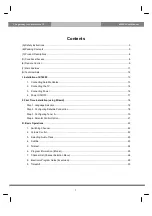
2
h. Do the same with the other ground lug and antenna
block.
i. Insert the receiverÕs two antennas through the two
openings in the top of the cabinet, one into each blockÕs
right-hand terminal, and tighten the screws to secure
them.
j. Affix the receiver's Summary of Connections label to the
inside of the control's cabinet door.
k. Discard the receiver's unused plastic cover and base.
3. If the receiver is to be located remotely from the
control
in its own plastic enclosure (not in a cabinet):
The circuit board mounting clips, grounding lugs and screws
included with the receiver will not be needed.
a. If concealed wiring is to be used, route it through the
rectangular opening at the rear of the base before
mounting. For surface wiring entry, a thin breakaway
area is provided along the base's right edge.
b. Mount the receiver in the selected location. For greatest
security, use all four mounting holes (two keyslot holes
and two round holes) provided in the plastic base.
c Affix the receiver's Summary of Connections label to the
inside of the housing cover.
4. Mounting the 5881EH in a Separate Cabinet For
Commercial Fire Applications.
For commercial fire applications, the 5881EH must be
mounted in a separate cabinet,
part # N4868V4ÐBE, using
the Ademco Cam Lock, Part #N6277, and Retainer Clip,
Part # N6277Ð1. Refer to the controlÕs instructions for
installing the Cam Lock and Retainer Clip in a cabinet.
The cabinet containing the receiver must be located no
farther than 20 feet from the alarm control cabinet., with no
intervening walls or barriers):
a. Remove the receiver's cover by inserting and twisting a
screwdriver blade in the slot at the center of the cover's
lower edge.
b. Remove the receiver's circuit board from its base by
removing two securing screws and bending back the
two flexible plastic tabs that hold the board's lower edge.
c. Mount the receiver board in the cabinet as follows:
Insert the top of the receiver board into the supporting
slots provided at the top of the cabinet (see Diagram 1
and Detail A which show how the top of the receiver
board is secured).
Secure the bottom of the receiver board with the 2
screws removed in step b above, using an insulating
washer (supplied) between the head of each mounting
screw and the PC board.
d. Affix the receiver's Summary of Connections label to the
inside of the cabinet door.
e. Discard the receiver's unused plastic cover and base.
5. Setting The DIP switches (All Receivers):
Set the receiver's DIP switch to identify the receiver's
address (refer to the DIP switch chart in Diagram 2).
5881EH Only:
DIP switch #5 is used on the 5881EH, as follows:
For commercial fire applications, DIP switch #5 MUST be
in the ON position.
Note:
All other system components, including the
control, must be approved for use in commercial
fire applications.
When the 5881EH is not used in a commercial fire
application, switch #5 should be placed in the OFF
position.
6. Insert the wiring plug (with 4 flying leads) into the
mating socket on the receiver
(see Diagram 2 for socket
location). Connect the
4 wires to the control's corresponding
remote keypad connection points (see ÒInterface WiringÓ in
the
SPECIFICATIONS
section).
7. Install the antennas
in the
right-hand
terminals of the two
terminal blocks at the upper edge of the circuit board, one
into each blockÕs right-hand terminal, and tighten the screws
to secure them.
If the receiver is mounted in a cabinet, insert the antennas
through the holes in the cabinet's top first, and then into the
terminal blocks.
Important!
If the receiver is mounted in a separate cabinet
in a commercial fire installation do not use the antenna
grounding lugs.
8. Replace the receiver's cover
if the receiver is not mounted
within a cabinet.
9. Proceed with any programming of the control that may
be necessary for RF operation, and the installation of
the system's wireless transmitters,
as described in the
control's installation instructions.
10. The LED located on the receiver's circuit board
should
be used as an indicator of strong local radio frequency
interference. If this LED is continuously illuminated, the
receiver should be relocated.
SPECIFICATIONS
Dimensions:
7-3/8" W x 4-3/8" (10-7/8Ó w/antennas) H x 1-7/16" D.
188mm W x 112mm H (277mm w/antennas) x 37mm D.
Input Voltage:
12VDC (from controlÕs remote keypad terminals).
Current:
4281/4281CN: 35mA. 5881/5882: 60mA.
Interface Wiring:
RED
12VDC input (+) Aux Power
GREEN:
Data Out to Control
YELLOW: Data In from Control
BLACK:
Ground (Ð)
Range:
200ft (60m) nominal indoors from wireless transmitters
(the actual range to be determined with the security
system in the TEST mode).
TO THE INSTALLER
Regular maintenance and inspection (at least annually) by the installer and frequent testing
by the user are vital to continuous satisfactory operation of any alarm system.
The installer should assume the responsibility of developing and offering a regular
maintenance program to the user, as well as acquainting the user with the proper operation
and limitations of the alarm system and its component parts. Recommendations must be
included for a specific program of frequent testing (at least weekly) to insure the system's
operation at all times.
www.PDF-Zoo.com

























